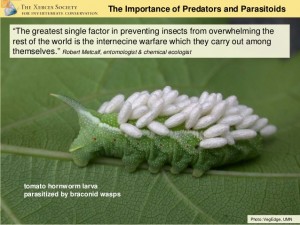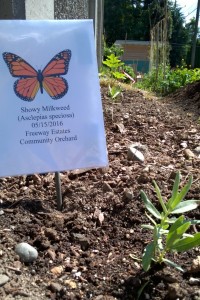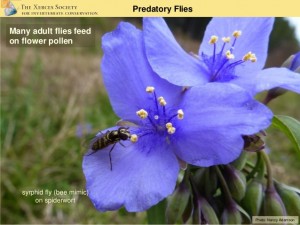Good Bugs Bad Bugs
July 29, 2016
Last month, I attended a class on Beneficial Insects taught by instructors from Xerces  (http://www.xerces.org/) and hosted by King Conservation District .
(http://www.xerces.org/) and hosted by King Conservation District .
Conservation biocontrol is the new catch phrase and the focus is on increasing the numbers and diversity of naturally occurring beneficial insects. The idea is that nature does a good job of keeping pest insects in control. Our part is to create habitat for the good bugs.
Beneficial insects need a place to eat, overwinter and reproduce. Keys to beneficial insect habitat include providing plant diversity and undisturbed areas.
 Plant diversity drives insect diversity. Ideally, your plants flower at different times of the year. Native plants support many more native insects than do non-native plants. Like pollinators, such as bees and butterflies, many insect predators and parasitoids feed on flower nectar or pollen during one of more of their life stages. (link for wildflowers of the native northwest – http://www.xerces.org/wp-content/uploads/2014/09/MaritimeNorthwestPlantList_web.pdf)
Plant diversity drives insect diversity. Ideally, your plants flower at different times of the year. Native plants support many more native insects than do non-native plants. Like pollinators, such as bees and butterflies, many insect predators and parasitoids feed on flower nectar or pollen during one of more of their life stages. (link for wildflowers of the native northwest – http://www.xerces.org/wp-content/uploads/2014/09/MaritimeNorthwestPlantList_web.pdf)
Undisturbed areas make the best homes for many insects. Desirable sites include grassless patches of earth or mulch, dead plants with hollow stems, rock and debris piles, and bunch grasses in elevated areas.
Uh oh! Not all flowering plants are favorable, depending on your crop. Sweet Alyssum (not native to the northwest) attracts pests such as flea beetles, Harlequin bug, and Bagrada bug. You might not want Alyssum if you are planting a Brassica such as arugula or mustard greens.
Even some native flowering plants are hosts for crop pests:
Hawthorn (Craetagus spp.) and Wild Plum (Prunus spp.) host the maggot fly
Wild Rose (Rosa spp.) hosts leafroller caterpillars
Willow (Salix spp.) and Elderberry (Sambucus spp.) host leafhoppers/sharpshooters
Wild Plum, Elderberry and Wild Raspberry (Rubus spp.) host the Spotted-Wing Drosophila (SWD)
Sat, Aug 20, 10-11, Intro Qi Gong
Sun, Aug 21, 10-12, Work Party
Sat, Aug 28, 10-11, Intro Qi Gong
Reducing pesticide use is another important step to support beneficial insects. We know not to  spray horticultural oils when the bees are active during the day. However, these instructors asked us to think beyond bees. Many insects are nocturnal, like our friendly slug eating beetles, so evaluate your pest control practices in consideration of all critters. Even organic-approved pesticides can harm beneficial insects; Pyrethrin and spinosad are broad-spectrum insect killers.
spray horticultural oils when the bees are active during the day. However, these instructors asked us to think beyond bees. Many insects are nocturnal, like our friendly slug eating beetles, so evaluate your pest control practices in consideration of all critters. Even organic-approved pesticides can harm beneficial insects; Pyrethrin and spinosad are broad-spectrum insect killers.
Following the classroom session, we toured a local organic farm to grade their site for beneficial insect friendliness. (Beneficial Insect Habitat assessment form and guide link – http://www.xerces.org/wp-content/uploads/2015/07/HAG_BeneficialInsects_June2015_web.pdf) There were attendees who could identify the plants in a hedgerow a hundred yards away! This habitat assessment included a good lesson in seeing how physically close the flowering plants should be to the crops, based on how far different insects travel in a day.
We left the class with the book, Farming with Native Beneficial Insects, (Xerces Society), which has excellent information including a chapter on how to transition areas full of invasive plants.
Links for good slideshows of these topics:
intergrating-native-pollinators-into-wildlife-conservation-practices
southern-sawg-farming-for-beneficial-insects-pollinators-predators
USDA supported on-demand webinars – http://www.conservationwebinars.net/
Look under Organic Agriculture for titles such as:
Evaluating, Establishing & Maintaining Habitat for Pollinators and Beneficial Insects
Farming for Beneficial Insects: Pollinators, Predators and Parasitoids
Mitigating Soil Disturbance in Organic Systems
Orchard Floor Management in Organic Systems
Ruth

Leave a Reply
Want to join the discussion?Feel free to contribute!